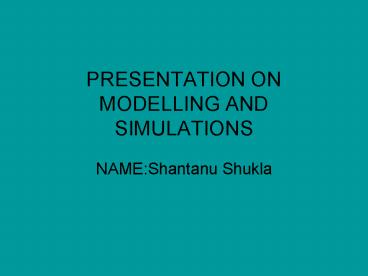PRESENTATION ON MODELLING AND SIMULATIONS - PowerPoint PPT Presentation
Title:
PRESENTATION ON MODELLING AND SIMULATIONS
Description:
PRESENTATION ON MODELLING AND SIMULATIONS NAME:Shantanu Shukla Modeling of VLSI semiconductor manufacturing processes The manufacture of complex integrated circuits ... – PowerPoint PPT presentation
Number of Views:99
Avg rating:3.0/5.0
Title: PRESENTATION ON MODELLING AND SIMULATIONS
1
PRESENTATION ON MODELLING AND SIMULATIONS
- NAMEShantanu Shukla
2
Modeling of VLSI semiconductor manufacturing
processes
- The manufacture of complex integrated circuits
demanded by present-day system designers requires
the assembly of a large number of interacting
process steps . - Many of these process steps cannot be chosen
without considering the effect of the other steps
involved in the manufacturing process. A great
deal of understanding of the basic physical
principles must be employed before a successful
manufacturing process can be defined.
3
FAULT MODELLING
- One of key modelling process is fault modelling
here we model the faults which might be present
in the chip like stuck at fault, delay fault,
transition fault. - Inadequate insight into the physics of processing
and manufacturing can cause many failures at
subsequent stages so its important to take into
account in modelling as well.
4
Logical fault Modelling
- Permanent and randomly occuring can be broadly
described as the two classes of logical faults. - Permanent ones are usually due to manufacturing
defects. - Their modelling is more rigorous but their
detection if done is applicable for a wide area
as owing to their spread over presence. But it
has been found that modelling of such faults e.
g spot defects is quite tough as their models
tend to be very complex.
5
Stuck at faults
- Though most primitive algorithms like D-Algorithm
and Podem which helped in generating models for
these faults didnt take multiple faults at once
they gave good results. - More evolves algorithms like FAN and others help
in generating less test vectors and test more
faults thus saving time and money.
6
CIRCUIT MODELLING
- A lot of research has gone into formulation of
CMOS device models. - For example analog circuit analysis is still a
research area. A new model which takes into
account bulk doping concentration ,fixed oxide
charge and effective carrier mobility its
superiority is owing to its not depending on Vt
(threshold voltage) and rather on above
characteristics. As Vt is dependent on
capacitance and Fermi potential leading to more
computing and related dependencies.
7
CIRCUIT MODELLING
- This model helps in building an analog circuit
simulator which gives predictive power and higher
control over outputs owing to control over
physical parameters described before.
8
Electromagnetic Modelling of VLSI Circuits
- The fast clock speed devices and high-density
interconnections of the multi-chip modules (MCMs)
have created problems such as multiple
reflections, crosstalk, skin effect, dispersion,
leakage, radiation, etc - The traditional CAD tools are based upon the
quasi-static analysis (QSA), which is a low
frequency approximation of the Maxwell equations.
- with sub-nanosecond rise time and tight physical
dimensions, the QSA is not generally valid. This
is because the electrical characteristics,
presented by skin effect loss, dispersion and so
on are not properly taken into account by the
QSA. The full-wave analysis of the
electromagnetic (EM) performance of the 3D
packaging structures is definitely needed.
9
Contined
- Recently, a new category of orthogonal
mathematical systems, "orthogonal wavelets," has
emerged. The major advantages of the wavelets
representation are their multi-resolution
analysis (MRA), vanishing moments, and
localization properties, both in the spatial and
spectral domain. The boundary integral equations
of the modeling work usually result in full
matrices - This enables us to solve real world 3D packaging
problems under full-wave regime. We can convert
these theoretical results into useful CAD tools
for modeling the EM behavior of complex 3D
interconnects, and transfer the field solutions
into circuit parameters
10
FAULT SIMULATION
- The previous models basically worked on gate
level description and took single stuck at line
faults into account-there were some major
problems because of this-some logic elements like
switching transistors and load devices could not
be taken as logic elements delay faults could not
be accounted for. Delays are represented by
lumped delay elements unsuitable in many cases
and sometimes logical values are also
constrainted(i.e may be only 0 and 1 are
available).
11
SOME IMPROVEMENTS
- A few shortcomings of existing simulators in the
context of VLSI design and testing are
considered. A fault simulation approach based on
CSA (connector-switch-attenuator) theory is
defined which overcomes many of these
deficiencies. - The CSA circuit elements and logic values needed
to model combinational circuits are described and
applied to the analysis of various types of MOS
circuits. A charge-storage element called a well
is introduced to simulate sequential behavior. - It is shown that many fault types, including
stuck-line faults, short circuits, open circuits,
and delay faults can be modeled in a uniform and
efficient manner.
12
LOGIC SIMULATION
- Logic simulation is used extensively to verify
the VLSI circuits before fabrication. - As time for testing tends to be the bottleneck
parallel processing and deductively working
simulation has fast replaced the older
approaches.
13
Continued..
- But parallel processing simulations face some
problems they are broadly compartmentalized as
circuit structure, timing granularity, target
architecture and synchronization of algorithm. - This synchronization algorithm helps multiple
processors work on the same simulation, thus
enhancing time utilization - And better performance results.
- But they still need more Research and development
on them.
14
THANK YOU

